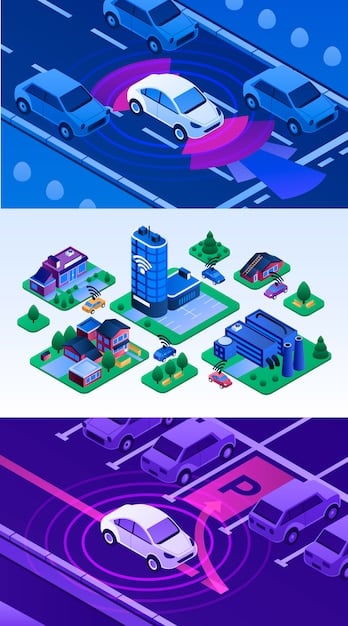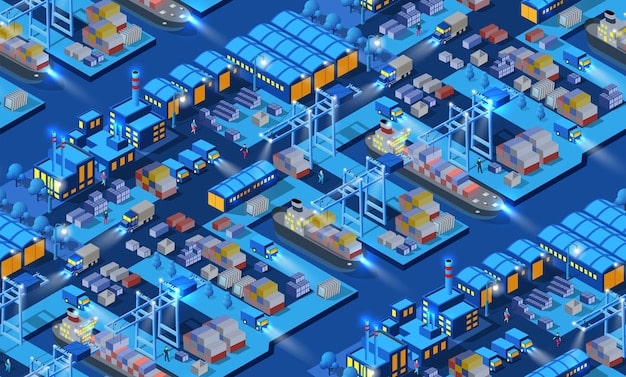Edge Computing’s Rise: Transforming US Businesses

Advertisements
The rise of edge computing is fundamentally reshaping how US businesses operate, bringing computation and data storage closer to data sources, thereby significantly reducing latency, improving real-time processing capabilities, and enhancing operational efficiency across various industries.
Advertisements
In an increasingly data-driven world, the quest for faster, more efficient data processing is relentless. Enter the rise of edge computing: how will it transform US businesses? This paradigm shift moves computation from centralized cloud servers to the “edge” of the network, closer to where data is generated. It’s a strategic evolution poised to redefine operational frameworks, decision-making, and service delivery across sectors.
Understanding the Edge: A New Frontier for Data
Edge computing isn’t merely a technological buzzword; it represents a fundamental rethinking of how data is processed, analyzed, and utilized. By decentralizing processing power, organizations can unlock unprecedented levels of efficiency and responsiveness.
Advertisements
The traditional model relied heavily on sending all data to a central cloud for processing. While effective for some applications, this approach introduces latency, especially for time-sensitive operations. Edge computing mitigates this by allowing computations to occur at or near the data source.
This localized processing has profound implications. For instance, in manufacturing, real-time analytics can detect machinery malfunctions before they lead to costly downtime. In retail, immediate insights from in-store sensors can optimize inventory and personalize customer experiences.
The Shift from Centralized to Distributed
The internet of things (IoT) has been a primary catalyst for edge computing’s ascent. With billions of connected devices generating zettabytes of data, sending every byte to the cloud becomes untenable. The sheer volume and velocity demand a paradigm shift.
- Reduced Latency: Critical for applications like autonomous vehicles and augmented reality that require instantaneous feedback.
- Bandwidth Optimization: Only processed, relevant data is sent to the cloud, significantly lowering network congestion and costs.
- Enhanced Security: Processing sensitive data locally reduces its exposure to external threats during transmission.
- Improved Reliability: Edge devices can operate even when connectivity to the central cloud is intermittent or lost.
This distributed architecture also fosters innovation, empowering businesses to develop new applications and services that were previously limited by network constraints. The ability to act on data at the point of origin opens new avenues for operational excellence and strategic advantage.
Ultimately, understanding the edge is about recognizing a new layer in the computing hierarchy—a layer that is rapidly becoming indispensable for US businesses seeking to thrive in a hyper-connected, real-time economy. It’s a foundational change that will dictate the pace of digital transformation.
Driving Efficiency and Innovation Across Industries
The practical applications of edge computing are diverse and far-reaching, promising to revolutionize how various US industries operate. Its ability to process data at the source translates directly into enhanced efficiency, accelerated innovation, and novel business models.
Consider the energy sector, where smart grids equipped with edge devices can dynamically balance supply and demand, detect outages instantly, and optimize resource distribution. This not only improves reliability but also streamlines operations, reducing waste and increasing responsiveness.
In healthcare, edge computing enables remote patient monitoring with real-time analytics, allowing for immediate intervention in critical situations. Wearable devices can process health data locally, alerting practitioners to anomalies instantly, enhancing preventative care and emergency response.
Edge Computing in Manufacturing
Manufacturing is perhaps one of the most visible beneficiaries of edge computing. The advent of Industry 4.0 relies heavily on interconnected systems and real-time data flows.
- Predictive Maintenance: Sensors on machinery analyze vibration, temperature, and other parameters at the edge, predicting potential failures before they occur. This reduces unscheduled downtime and maintenance costs significantly.
- Quality Control: Edge-enabled vision systems can inspect products on the production line, identifying defects instantly and ensuring consistent quality without human intervention.
- Automated Operations: Robotics and automated guided vehicles (AGVs) leverage edge processing for navigation and task execution, enhancing the efficiency and safety of factory floors.
These capabilities lead to optimized production schedules, reduced waste, and a leaner operational footprint. Manufacturers can achieve higher throughputs with fewer errors, bolstering their competitive edge in a global market.
Beyond manufacturing, the retail industry is leveraging edge for personalized shopping experiences, inventory management, and fraud detection. Smart stores use edge analytics to understand customer foot traffic, optimize product placement, and manage supply chains more effectively.
The transformation driven by edge computing isn’t limited to large enterprises; small and medium-sized businesses (SMBs) are also finding innovative ways to adopt this technology, leveraging affordable edge devices and cloud-edge hybrid solutions to gain a competitive advantage and streamline operations previously only accessible to larger corporations.

Challenges and Opportunities for US Businesses
While the promise of edge computing is undeniable, its widespread adoption by US businesses comes with a unique set of challenges. Navigating these obstacles is crucial for realizing the full potential of this transformative technology.
One primary concern revolves around security. Distributing computation across numerous edge devices expands the attack surface, making it more challenging to secure sensitive data and ensure system integrity. Robust encryption, authentication protocols, and continuous monitoring are paramount.
Interoperability is another hurdle. The diverse ecosystem of edge devices, sensors, and platforms often lacks standardized communication protocols, complicating integration and data exchange. Developing common standards and open APIs will be essential for seamless deployment.
Overcoming Data Management Complexities
Managing data at the edge introduces significant complexities. Businesses need strategies for data collection, storage, processing, and transfer, ensuring data integrity and compliance with regulations like GDPR or CCPA. Edge-to-cloud data synchronization also presents challenges.
- Data Governance: Establishing clear policies for data ownership, access, and usage across distributed edge environments.
- Scalability: Designing edge infrastructure that can scale effectively to accommodate increasing numbers of devices and data volumes.
- Resource Management: Optimizing power consumption and processing capabilities of edge devices, particularly in remote or resource-constrained environments.
Recruiting and retaining skilled professionals capable of designing, deploying, and maintaining edge solutions is also a growing challenge. The demand for expertise in areas like IoT, AI/ML at the edge, and cybersecurity is rapidly outstripping supply.
Despite these challenges, the opportunities presented by edge computing are immense. For US businesses, early adoption can translate into a significant competitive advantage, enabling new revenue streams, optimizing existing processes, and fostering a culture of innovation.
The key lies in strategic planning, investing in the right technologies, and building a skilled workforce. Businesses that approach edge computing with a clear understanding of both its potential and its pitfalls will be best positioned to harness its transformative power.
Edge Computing and the Future of AI/ML
The intersection of edge computing and artificial intelligence (AI) or machine learning (ML) is a particularly potent combination, poised to redefine how intelligent systems operate and deliver value. This convergence moves AI processing beyond centralized data centers, bringing advanced analytics directly to where data is generated.
Consider AI models that require real-time inference, such as those used in autonomous vehicles. Sending sensor data to the cloud for processing introduces unacceptable delays. By embedding AI capabilities at the edge, decisions can be made instantaneously, enhancing safety and responsiveness.
Similarly, in smart cities, edge AI can analyze traffic patterns, pedestrian movements, or potential security threats in real time without sending vast amounts of video data to the cloud. This not only improves response times but also addresses privacy concerns by processing data locally.
Decentralizing Intelligence
Decentralizing AI processing has several key advantages:
- Instantaneous Insights: AI models can provide immediate analysis and activate responses at the point of action, which is vital for critical operations.
- Reduced Bandwidth Needs: Only the insights, not the raw data, need to be sent back to the cloud, significantly cutting down on data transmission.
- Enhanced Data Privacy: Sensitive data can be processed and often discarded at the edge, minimizing the risk of exposure during transit to and from the cloud.
- Offline Operation: Edge AI systems can continue to function and make intelligent decisions even if network connectivity is interrupted.
Healthcare is another sector where edge AI is proving transformative. AI-powered diagnostic tools embedded in medical devices can analyze patient data locally, providing immediate insights to clinicians. This accelerates diagnoses and allows for more timely interventions, especially in remote or underserved areas.
The future of AI/ML is intrinsically linked to edge computing. As AI models become more sophisticated and the demand for real-time intelligence grows, the need to deploy these models closer to the data source will intensify. This shift promises to unlock a new era of proactive, intelligent automation across all industries, providing US businesses with unprecedented analytical power.
Security and Privacy Considerations at the Edge
As edge computing distributes processing power closer to data sources, it inherently introduces new security and privacy challenges that US businesses must navigate with diligence. The expanded attack surface and the decentralized nature of edge deployments necessitate a robust and multi-faceted security strategy.
Each edge device, from a sensor in a factory to a camera in a retail store, represents a potential entry point for malicious actors. Protecting these endpoints from unauthorized access, malware, and data breaches becomes a critical concern. Furthermore, securing data in transit as it moves between edge devices, local servers, and the cloud requires strong encryption and secure protocols.
Another significant consideration is data privacy. As data is processed closer to its source, particularly in sensitive environments like healthcare or personal surveillance, ensuring compliance with evolving privacy regulations (e.g., CCPA, state-specific privacy laws) is paramount. The ability to perform anonymization or aggregation of data at the edge can help mitigate some privacy risks.
Mitigating Edge Risks
Effective security at the edge requires a comprehensive approach that includes:
- Robust Authentication and Authorization: Implementing strong mechanisms to verify the identity of devices and users, and controlling their access to resources.
- Data Encryption: Encrypting data both at rest on edge devices and during transmission to prevent eavesdropping and unauthorized access.
- Regular Software Updates: Ensuring that edge devices and their operating systems are regularly patched and updated to address known vulnerabilities.
- Network Segmentation: Isolating edge networks from core enterprise networks to contain potential breaches and limit their impact.
- Continuous Monitoring and Threat Detection: Deploying systems that can monitor edge device behavior, detect anomalies, and alert security teams to potential threats in real time.
Edge devices themselves often have limited computational resources, making it challenging to implement complex security software directly on them. This necessitates a balance between functionality and security, often relying on centralized security management platforms that can oversee and enforce policies across distributed edge environments.
The “trust no one” approach, or zero-trust architecture, is increasingly being adopted for edge deployments, where every request for access is thoroughly verified regardless of its origin. This paradigm shift in security thinking is essential for building resilient and secure edge ecosystems.
Ultimately, a proactive and adaptive security posture is vital for any US business looking to harness the power of edge computing. Ignoring these considerations can lead to severe financial, reputational, and legal consequences, undermining the very benefits that edge technology promises.
Implementation Strategies for US Businesses
Successfully integrating edge computing into existing operations requires carefully considered implementation strategies for US businesses. It’s not simply about deploying devices; it’s about strategic planning, phased adoption, and fostering an agile approach to technology.
First, businesses must identify clear use cases where edge computing can deliver tangible benefits. This often involves a thorough assessment of current pain points, such as high latency in real-time applications or excessive bandwidth costs associated with transmitting large volumes of raw data to the cloud. Start small, perhaps with a pilot project in a single department or facility, to validate the technology and gather practical insights. This iterative approach allows for adjustments and fine-tuning before a broader rollout.
Another crucial strategy involves selecting the right edge hardware and software. The market offers a wide array of edge devices, from powerful servers to compact, specialized sensors. The choice depends on the specific computational needs, environmental conditions, and security requirements of each application. Cloud providers are also increasingly offering edge-compatible services, enabling hybrid cloud-edge architectures that leverage existing infrastructure while extending capabilities to the edge.
Building an Edge-Ready Workforce and Infrastructure
The successful deployment of edge computing heavily relies on human capital and robust infrastructure. Businesses need to invest in training and upskilling their IT teams to manage and maintain distributed edge environments. This includes expertise in network security, IoT device management, and potentially AI/ML model deployment at the edge.
- Strategic Partnerships: Collaborating with technology vendors, system integrators, and industry experts can accelerate deployment and provide access to specialized knowledge.
- Scalable Architecture: Designing an edge architecture that can easily scale to accommodate future growth and new applications without significant re-architecting.
- Operational Simplicity: Prioritizing solutions that offer centralized management and automation capabilities to reduce the complexity of managing a distributed network of edge devices.
- Data Synchronization and Management: Implementing robust strategies for data synchronization between edge and cloud environments, ensuring data consistency and integrity.
Furthermore, businesses should consider developing a continuous feedback loop. This means constantly monitoring the performance of edge deployments, collecting data on efficiency gains and challenges, and using these insights to refine strategies. User feedback from employees directly interacting with edge-enabled systems is invaluable for optimizing workflows.
Finally, fostering a culture of innovation and adaptability is key. Edge computing is an evolving field, and businesses that embrace experimentation and are willing to adapt their strategies will be better positioned to capitalize on its full potential. By taking a methodical yet agile approach, US businesses can effectively leverage edge computing to drive significant operational improvements and competitive advantages in the years to come.

The Economic Impact and Future Outlook
The rise of edge computing is not just a technological shift; it’s a significant economic force that will reshape industries and redefine competitive landscapes for US businesses. Its true impact is only beginning to be felt, promising a future characterized by hyper-efficiency, unparalleled responsiveness, and new avenues for economic growth.
Economically, edge computing is expected to drive substantial investments in infrastructure, hardware, and specialized software. This, in turn, will create new jobs in areas like network engineering, data science, cybersecurity, and solution development. The ability to extract real-time insights from data at the edge will lead to optimized resource allocation, reduced operational costs, and increased productivity across various sectors.
Consider the potential for cost savings in industries like logistics and transportation, where edge devices can optimize routes, manage fleets, and predict maintenance needs, leading to significant reductions in fuel consumption and operational expenditure. Similarly, in agriculture, edge analytics can optimize irrigation, fertilization, and pest control, boosting yields and reducing waste.
Market Trends and Projections
Market projections indicate robust growth for the edge computing sector. Analysts predict a multi-billion dollar market within the next few years, driven by increasing adoption across enterprises, the proliferation of IoT devices, and the growing demand for real-time data processing. This growth will be fueled by both hardware sales and software services.
- Increased Investment: Businesses are expected to significantly increase their spending on edge infrastructure and solutions to gain a competitive advantage.
- Emergence of New Business Models: Edge computing will enable innovative services and products that were not feasible with traditional cloud-centric architectures.
- Ecosystem Development: A vibrant ecosystem of hardware manufacturers, software developers, and service providers will continue to emerge, offering diverse solutions.
- Sustainability Initiatives: Edge computing can support sustainability goals by optimizing energy consumption in smart buildings and industrial processes.
The future outlook for edge computing in the US is extremely promising. As 5G networks become more ubiquitous, providing the high-bandwidth, low-latency connectivity that edge solutions thrive on, its adoption will accelerate further. The convergence of edge, 5G, and AI is set to unlock unprecedented capabilities for businesses, fostering an era of truly intelligent operations.
US businesses that proactively embrace and strategically implement edge computing will be best positioned to capitalize on these trends, securing their place at the forefront of digital innovation and driving economic value in the decades to come. The long-term economic impact will be profound, enhancing competitiveness and enabling entirely new paradigms of operation.
| Key Point | Brief Description |
|---|---|
| ⚙️ Decentralized Processing | Moves data processing closer to the source for real-time insights and reduced latency. |
| 🚀 Efficiency & Innovation | Drives significant operational improvements and enables new business models across industries. |
| 🔒 Security Challenges | Requires robust strategies for managing an expanded attack surface and data privacy. |
| 💡 AI/ML Synergy | Integrates AI capabilities at the edge for instantaneous intelligent decision-making. |
Frequently Asked Questions About Edge Computing
▼
Edge computing processes data closer to its source, at the “edge” of the network, rather than sending it all to a centralized cloud. This reduces latency, saves bandwidth, and enables real-time decisions. Cloud computing, conversely, involves processing data in remote data centers, offering scalability and broad accessibility for less time-sensitive tasks.
▼
Industries relying on real-time data and low latency stand to gain the most. Key beneficiaries include manufacturing (for predictive maintenance and quality control), healthcare (for remote patient monitoring and immediate diagnostics), retail (for personalized experiences and inventory management), and transportation (for autonomous vehicles).
▼
The main security concerns include protecting a larger attack surface due to numerous distributed devices, securing data in transit between the edge and cloud, and managing device authentication. Data privacy also becomes critical due to localized processing of sensitive information, requiring robust encryption and access controls.
▼
Edge computing enables AI by allowing AI models to run directly on edge devices, processing data locally. This provides instantaneous insights and actions, which is crucial for applications like autonomous systems and intelligent surveillance. It also reduces bandwidth needs and enhances data privacy by minimizing the transmission of raw data.
▼
Businesses should start by identifying clear use cases, conducting pilot projects, and selecting appropriate hardware/software. Investing in workforce training, establishing robust security protocols, and designing a scalable architecture are also crucial. Strategic partnerships can further assist in successful edge computing adoption and integration.
Conclusion
The advent of edge computing marks a pivotal moment in the evolution of digital infrastructure, fundamentally reshaping how US businesses interact with data. By moving computation closer to the source, it unlocks unparalleled efficiency, fosters innovation, and enables a new generation of real-time applications that were previously impossible. While challenges related to security, data management, and interoperability exist, strategic planning and a proactive approach can mitigate these risks. As the symbiotic relationship between edge computing, AI, and 5G strengthens, its transformative impact on virtually every sector, from manufacturing to healthcare, will only intensify, solidifying its role as an indispensable component of the modern enterprise landscape.





